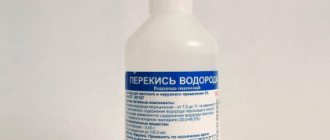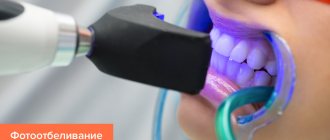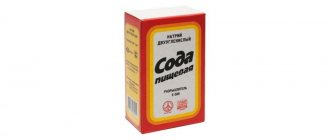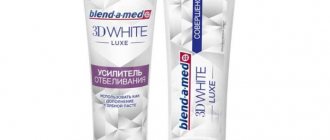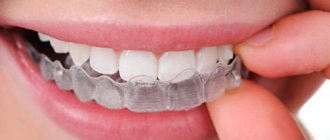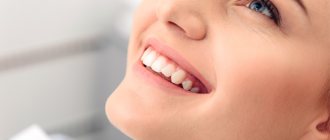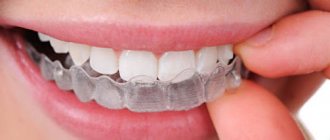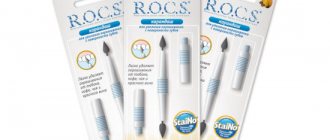Teeth whitening is one of the most popular aesthetic procedures nowadays. An attractive smile gives you self-confidence and increases your chances of social success. Therefore, many people come to the dentist not only for dental treatment, but also for cosmetic procedures. But is it necessary to consult a doctor with questions of beauty and aesthetics? Maybe home manipulations in pursuit of a snow-white smile are enough?
A person always has an alternative on how to solve the problem of teeth whitening. The first way is expensive procedures in the dentist’s office, the second option is folk recipes for home use, the third is the search for special whitening products in the pharmacy assortment.
Teeth whitening products at the pharmacy
What teeth should be naturally?
We can list many examples that were considered a trend at one time, but at the same time were harmful to health. For example, women's corsets, which squeezed the internal organs so that they took away their breath and disrupted the functioning of the internal organs. The situation with teeth is approximately the same. Dentists confirm that our human smile is not snow-white by nature, but yellowish. This is normal and indicates oral health.
Despite popular belief, the enamel that covers the tooth is almost transparent and not white. Beneath it is dentin, the main tissue of the tooth, which naturally has a yellowish tint. It is this that “shines through” the enamel and gives it its characteristic yellowness. And most importantly, this shade indicates the health of the teeth, their strength and resistance to caries. If a person’s teeth are naturally too white, this indicates poor enamel mineralization and requires treatment.
Therefore, the first thing when consulting a visitor with the problem of yellow teeth is to determine whether the problem is acquired or whether it is a habitual condition of the teeth.
Indications for teeth whitening ZOOM 4
Any dental procedure has indications for implementation, teeth whitening ZOOM 4 is no exception in this regard. Zoom 4 will be the most effective and useful procedure for you under the following circumstances:
- The enamel of your teeth has darkened due to drinking tea, coffee, smoking, and frequent consumption of coloring foods;
- With age-related darkening of tooth enamel;
- ZOOM 4 whitening can be used by people suffering from fluorosis, a disease that causes spots and streaks to appear on the enamel of teeth;
- When the enamel darkens due to long-term treatment with drugs of the tetracycline group.
NOTE: In the article we will provide photos before and after ZOOM 4 whitening, but you should understand that your result may differ from the examples given, since the degree of teeth whitening for each person is individual and it also depends on the initial state of the enamel, its natural shade, depth of dentin colored with pigments.
Why do teeth change color?
In order to properly conduct a consultation, a pharmacist or pharmacist must find out the cause of the defect. Dentists identify a number of factors that change the color of teeth:
- Consumption of certain foods and drinks that contain natural or artificial colors: blueberries, chocolate, beets, black tea, coffee, dark juices, etc.
- Bad habits. Smoking and chewing tobacco gives an unsightly yellow tint and spoils the overall condition of teeth.
- Insufficient hygiene. Improper and irregular tooth brushing is the main factor in changing the shade of dentin
- Caries and other dental diseases;
- Internal causes: lack or excess of fluoride, metabolic disorders, genetic diseases
- Fillings and restorations
- Aging. Dentin turns yellow with age
- Taking medications: tetracycline, iron and others
- A combination of several reasons.
A pharmacist or pharmacist can help with the first three reasons. If systemic or dental diseases are suspected, the visitor should be advised to consult a doctor.
How the result is achieved
People who have used teeth whitening powder compare its effect to that of professional cleaning. The fact is that the powder does not allow achieving pronounced whiteness, but it returns the enamel to its natural color. At the same time, he polishes the surface of the crown, making it smooth and shiny.
The principle of operation of the powder is very simple - it consists in the fact that abrasive particles mechanically remove soft and hard deposits from the surface of the teeth, and also clean off the pigmented layer.
The main component of the powders is chalk, which is not only capable of removing plaque, but also has remineralizing properties.
To enhance the whitening effect, manufacturers add various components to the powder. One of the most popular options is lemon essential oil. The substances contained in its composition neutralize pigments. In addition, the composition includes bicarbonate of soda, which is also an abrasive. In order for the powder to freshen breath, various plant extracts are added here: ginger, mint, cinnamon and others. For a therapeutic effect, anti-inflammatory additives of plant origin are added to the powder. Usually these are extracts of licorice, St. John's wort, nettle, etc. They reduce bleeding gums and reduce other effects that arise due to periodontal inflammation.
What is better whitening paste or powder?
Today, few people use tooth powder, since most people prefer the most common remedy - toothpaste. People think about powder when they think about lightening enamel. As a bleaching agent, it can be much more effective than paste, due to the fact that the concentration of abrasive elements is much higher. Solid particles make it possible to loosen deposits much faster and remove the colored layer of the crown. Therefore, those who strive to quickly achieve the desired result turn to tooth powder. But it is worth remembering that this product should be used very carefully, as it can greatly harm the health of the enamel.
If you want to achieve a noticeable and long-term effect without risking the integrity of your teeth, you can choose the professional whitening paste “ASEPTA PLUS” GENTLE WHITENING. This safe and effective product will help neutralize surface staining of enamel. The advantages of the paste are that in just four weeks you will get visible results without damaging your teeth. The paste contains potassium citrate and hydroxypatite, which mineralize the enamel and prevent hypersensitivity. Extracts of calamus and eleutherococcus strengthen the gums and accelerate the restoration of the mucous membrane.
If you want, you can use the paste and powder together.
Recommendations for using teeth whitening powder
In order to achieve the desired result and at the same time not spoil tooth enamel, you need to take into account the features of the product, properly prepare for whitening and follow simple recommendations:
- It is highly advisable that your dentist select the powder, since when choosing, he will take into account the general condition of the gums and teeth.
- Try not to dip a wet brush into a box of powder, as the remaining mixture will partially absorb moisture, which may affect its properties. It is best to dilute the powder in a separate container each time before applying it to the brush until it becomes a thick paste.
- To minimize the risk of injury to the enamel, use a brush with soft bristles.
- Do not use the product for more than ten days.
- After you have brushed your teeth, use a special rinse that helps restore enamel after intensive brushing. An additional bonus will be fresh breath, which will especially please people who smoke. Since powder does not always cope well with this task.
How to clean
The procedure itself is not much different from daily brushing with regular toothpaste. It should also be done twice a day, morning and evening. The duration of one cleaning should be at least 3-4 minutes.
The process itself consists of the following stages:
- Apply the powder to a dampened brush;
- start cleaning from the front crowns, all movements should be very careful;
- you should move the brush along a vertical plane, this will significantly reduce the risk of scratching the enamel;
- continue brushing for at least two minutes;
- Apply a new portion of powder to the brush and repeat the cleansing movements for another 2 minutes.
- After the procedure, rinse your mouth thoroughly to thoroughly remove any remaining product;
- Rinse your mouth with a special mouthwash.
Tooth powder can be used as a dental treatment. To do this, you need to dilute the substance to a liquid porridge and carefully apply it with a swab to the crowns and gums. Next, you need to wait 10 minutes and rinse off the composition with boiled water; this procedure can also be combined with standard brushing of teeth using toothpaste.
How to save the effect
During and after whitening procedures, you should take more careful care of your teeth. The fact is that no matter how careful you are, abrasive substances will still have a negative effect in addition to the benefits. In some cases, tooth sensitivity to hot and cold foods may increase. This should go away quickly, but if sensitivity continues to increase, be sure to consult a specialist. The same should be done if pain, gum irritation, allergies and other problems occur.
In addition, for the effect to be noticeable, it is necessary to limit the consumption of foods containing large amounts of coloring substances. Temporarily eliminate the following foods and drinks from your diet:
- Black tea, coffee, red wine, colored lemonades;
- Berries - blueberries, blackberries, sea buckthorn, etc.;
- Lemons and oranges;
- Chocolate;
- Etc.
Also, if you smoke, you should reduce the number of cigarettes you consume per day as much as possible.
In addition, it is useful to have a professional hygienic cleaning done once or twice a year. It is recommended by WHO, as it not only preserves dental health, but also improves the body’s immunity.
This procedure can be performed in several ways, two of the most common:
- Cleaning using an Air Flow device, which delivers a stream of water with a fine abrasive under pressure. This procedure allows you to get rid of soft plaque and neutralize yellowness.
- Ultrasonic cleaning removes not only soft plaque, but also tartar.
Both procedures are safe and effective. With their help, you can reveal the natural color of the enamel, getting rid of unwanted accumulations.
Alternative options
If you want to achieve a snow-white smile, you should see a dentist. The fastest and most effective methods here will be in-office whitening methods, which are carried out using a laser, cold LED lamps, ultraviolet light, etc. The essence of this whitening is approximately the same: a special gel based on hydrogen peroxide is applied to the teeth, and it is exposed to light, activating oxygen. It is this that neutralizes the yellow pigment on the enamel.
Additionally, there are many professional at-home whitening methods available. In this case, a series of procedures is also carried out using a gel, only the concentration of the active substance in it is much lower. Because of this, the whitening period is significantly extended, but each procedure is more gentle. For home whitening, the dentist prepares special trays that follow the shape of the teeth. These mouth guards contain the active substance. It is often left overnight.
ASEPTA for healthy whitened teeth
A series of professional ASEPTA products for the care and treatment of teeth and gums will help you restore enamel weakened after whitening, eliminate inflammation of soft tissues, and reduce bleeding gums. The complex includes effective toothpastes, rinses and vitamins. You can easily choose the best option.
Types of teeth whitening
Whitening is a cosmetic procedure aimed at changing the color of dentin. It can be professional or home. Professional whitening (chemical/ultrasonic/laser/photo whitening) is performed by a dentist in an office or clinic. These methods are considered the safest and most effective.
For home whitening, traditional methods and special products are used. It is the latter that pharmacists and pharmacists deal with. In addition, these products may be recommended by dentists as the final stage of professional whitening, usually 2 weeks after the procedure. Special whitening products are given to the patient in the clinic, or he buys them at the pharmacy as prescribed by the doctor.
Carbamide peroxide-based products are widely used in both home and professional whitening. It consists of hydrogen peroxide and urea peroxide. When it hits the surface of a tooth, the substance disintegrates to form atomic oxygen. The latter penetrates the dentin and destroys the yellow pigment.
When carrying out the procedure in the clinic, high concentrations of carbamide peroxide of 10% and above are used. You need to be careful with them, as they can cause severe burns. To enhance the effect, the gel with the active substance is irradiated with special lamps. For home use, concentrations of the active substance range from 4 to 7.5%.
It is worth saying that this substance is approved by the American and Russian Dental Associations and recommended for use. Products that contain acids or abrasives should be used with extreme caution and it is best to consult a doctor before using them.
Is it possible to whiten teeth using a pharmacy mouthwash?
Another product that the pharmacy may offer you is mouthwash. Such preparations perfectly freshen breath and can remove food debris from the interdental spaces. This is a good prevention of caries and periodontitis; rinses and plaque are removed. Because of it, tooth enamel darkens, so this is what you need to fight against.
Mouthwash
Rinse aid is only an aid and will not solve the problem of regular cleaning. Therefore, it is usually used in combination, as the final stage of a daily hygiene procedure. Most likely, the pharmacy will recommend you a set of certain whitening products, which will also include a rinse aid.
Despite the apparent simplicity of this product, you should consult your dentist about choosing a mouthwash that is beneficial for you. Knowing what problems need to be solved in a particular case, the doctor will recommend a rinse with the optimal composition.
Mouthwash "Blue Pearl" whitening
Are there any contraindications?
There are several diseases and conditions for which professional and home whitening using products containing carbamide peroxide is not recommended:
- Pregnancy and breastfeeding, as the procedure may cause increased sensitivity of the teeth.
- Age up to 18 years. Before this period, the procedure cannot be carried out according to the instructions.
- Cracks, chips. Damage and defects can cause the composition to penetrate deep into the tooth tissue and lead to a burn of the pulp.
- Caries and carious cavities. If this problem is not eliminated before manipulation, the application of a bleaching agent will lead to softening of the dentin and aggravation of the disease.
Advantages and disadvantages of tooth powders
The principle of action of tooth powders continues to this day. All compositions contain various abrasives, usually chalk, but today various minerals, essential oils and plant extracts are added to them, this gives the powders the following advantages:
- the effect of herbal supplements helps reduce periodontal inflammation;
- swelling and bleeding of the gums decreases;
- when using the powder, normalization of the acid-base balance in the oral cavity is noted;
- The powder perfectly removes soft plaque and prevents the formation of tartar;
- during cleaning, the enamel is saturated with minerals, which is an effective prevention of caries;
- The cleaning procedure is very simple and does not require additional instructions.
But if you plan to use tooth powder, keep in mind that the product also has its disadvantages:
- The whitening effect is mainly achieved through abrasive, so if you apply the powder too often, there is a high risk of damaging the outer layer of the crown, which will increase the risk of caries and contribute to other unpleasant consequences.
- Due to the powder form, some fillers cannot be added to the composition, which could enhance the whitening effect.
- The powder is stored in unsealed packaging and in order to brush your teeth you will have to dip the brush into the mass several times, so the packaging should only be used by you. Dipping an unclean brush into the powder promotes the proliferation and accumulation of bacteria, which then enter the oral cavity.
- This product can only be used by people with normal tooth sensitivity.
- Essential oils that are part of the powder can cause allergies and irritation. If you notice this, stop using the product and contact a specialist.
Teeth whitening products in pharmacies
The pharmaceutical market offers the following products for home whitening:
| Facilities | Peculiarities | Examples |
| Toothpastes and powders | The brightening effect is manifested by abrasive components (calcium compounds, aluminum oxide, calcium carbonate, magnesium carbonate, polyphosphates, bentonite clay, silicon oxide, dicalcium phosphate), acids, peroxide, oxygen or specific enzymes. With regular use of abrasives, it is possible to achieve a change in tooth color by 1 tone, no more, and at the same time they damage the enamel. Therefore, these products must be used carefully and for no more than a month. Acidic, peroxide and oxygen pastes are not recommended for those with sensitive teeth. Enzymes papain, bromelain and titanium dioxide are whitening ingredients that gently lighten and are suitable for long-term use. | Examples of non-abrasive toothpastes:
|
| Rinse aids | The lightening quality of these products is minimal. Their release form does not allow for long-term and effective contact of the whitening components with the tooth surface. Therefore, rinses have a different role - to increase the effectiveness of toothpaste, wash away food debris, normalize pH, destroy microorganisms, freshen breath and thereby improve oral hygiene. |
|
| Gels | Gels usually contain carbamide peroxide, a substance that breaks down the pigment in tooth dentin. Gels sold in pharmacies are inferior in effectiveness to professional ones. The percentage of the active component in them is lower and without special equipment the result will not be so obvious. But they do not require special equipment and are safe to use, so they are popular at home. |
|
| Mouthguards | Mouthguards are not independent means for whitening; they enhance the effectiveness of gels. The whitening solution is applied to the teeth, and then the mouth guard is worn for several hours or overnight. In pharmacies you can also find kits that include LED lamps. Their task is to activate the gel and speed up the procedure. When consulting, you need to pay attention to the size of the mouthguard. There are two types sold in pharmacies: standard or thermoplastic. The latest model, after heating under hot water, takes the shape of a human jaw and is considered more effective. |
|
| Pencils | This is a whitening gel in a form that is more convenient to use. The active substance, as a rule, is the same carbamide peroxide. |
|
| Stripes | They are impregnated with a whitening composition based on carbamide peroxide and glued to the teeth overnight or for several hours. A convenient and inexpensive method that has gained great popularity. Their essence is the same as that of mouthguards - to increase the efficiency and uninterrupted supply of active components to the tooth tissues. |
|
| Pills | They clean dentures. According to the instructions, dissolve the tablet in water and immerse the prosthesis in the prepared solution. Main effects:
Due to this hygiene, dentures will not change color over time. |
|
Whitening strips: how effective are they?
Disposable whitening strips are also in great demand. They look like flexible, rather thin plates; a gel-like medicinal composition is applied to them. Lightening from 1 to 4 tones is the effect that strip manufacturers promise.
- Teeth whitening products at the pharmacy
Whitening strips
This product is recommended for people with yellowish or grayish enamel, coffee lovers, tea drinkers and smokers. Strips are also in demand by people who wore braces.
Extreme White Crestal whitening strips
The strips operate using peroxide gel (hydrogen peroxide + urea). When the film is removed from the strip itself, the gel begins to work actively. Hydrogen peroxide is responsible for the production of oxygen ions, which have oxidizing properties. These ions enter the deep layers of the tooth and destroy all pigments into ordinary water and carbon dioxide. This is how the enamel brightens.
What else do you need to know about whitening strips?
- These are disposable products, each strip is used only once.
- The procedure is carried out 1 or 2 times a day (depending on the instructions in the instructions).
- Strips made for the upper row of teeth are usually longer than those created for the lower row.
- Depending on the model and type of strip, it will last from five minutes to half an hour (the action time cannot be exceeded without permission).
- After removing the product from your teeth, you need to brush your teeth and rinse your mouth.
Using strips
Naturally, while the strips are in effect, you cannot eat or drink. You can talk, but it's unlikely to be comfortable. The whitening course is specified by the manufacturer; on average, it lasts 2 weeks. While you are taking the course, avoid strong tea, coffee, and products that actively stain your enamel.
Table. Pros and cons of drugstore whitening strips
| pros | Minuses |
| The procedure is carried out at home | You may experience dental hypersensitivity for several days |
| Quick results - the desired effect is achieved in a few days | There is still a risk of an allergic reaction |
| No aggressive effect on enamel | The strips are not always tightly fixed to the teeth, which is why whitening may be uneven |
| The result lasts for a long time, from six months to a year | Cannot be used if you have serious dental problems |
| The procedure is safe and painless | Does not bleach complex cases of pigmentation, such as fluorosis |
| The strips are available and the price for this product is quite reasonable | Cannot be used if there are several fillings on the front teeth |
How to use strips - photo
Naturally, these strips are also not used for removable or fixed prosthetics. They are not recommended for use by expectant mothers and women during lactation. Do not allow children to use this product. For stomatitis, gingivitis and periodontitis, this method of whitening is also prohibited. For people suffering from bronchial asthma and severe forms of epilepsy, strips are contraindicated.
Crest 3D White
As in all similar situations, it is best to coordinate the choice of whitening products with your dentist. Only he sees and professionally evaluates the condition of your oral cavity. Therefore, the dentist’s recommendations will be personal, and the universal nature of other advice deprives you of the possibility of an individual approach in choosing care and hygiene products.
- Visual test strips for determining protein in urine Uribel No. 50
Which method do you recommend?
The choice will primarily depend on the problem with which the visitor came to the pharmacy. If yellowness is associated with food, bad habits or insufficient hygiene, a pharmaceutical specialist may advise changing the usual paste to a whitening one and additionally offering mouth guards, gels, pencils or strips for use once a week or a short course (the course depends on the type of product).
It is also worth warning that the effect of home whitening will always be less pronounced than that of professional whitening. This will help eliminate objections in the future and prevent the formation of inflated expectations from the procedure. It is better to recommend products from the same series and line, since they usually complement each other and are compatible in composition.
When consulting, it is imperative to clarify whether the patient has caries, whether teeth have been restored or dentures have been installed. If you have cavities or black staining, it is important to recommend seeking help from a dentist. It is also necessary to refer the patient to a doctor if there is a suspicion of diseases of the internal organs, for example, liver diseases, diabetes, oncology, etc. You can assume this problem in a person by asking questions. If previously the color of the teeth was one, but then changed and other symptoms are observed: pain in a certain area, itching of the skin, excessive urination or sweating, etc., in this case it is definitely recommended to refer the patient to a doctor.
Consulting algorithm
We answer questions live on VKontakte: https://vk.com/pharmznanie
You can discuss the latest news with all your Russian colleagues in chats: Telegram: https://tglink.ru/pharmordenVKontakte: https://vk.me/join/AJQ1d_D2XxaDy9IdzL0e6EqH To leave a comment on the article, you need to register or log in.
Interested in the article? You can find out even more in the section Working in a pharmacy


